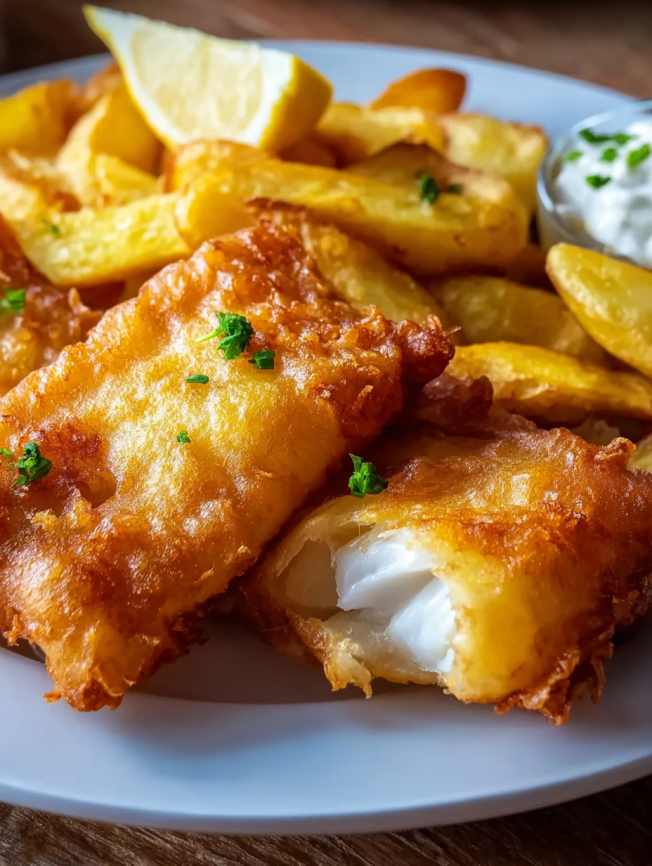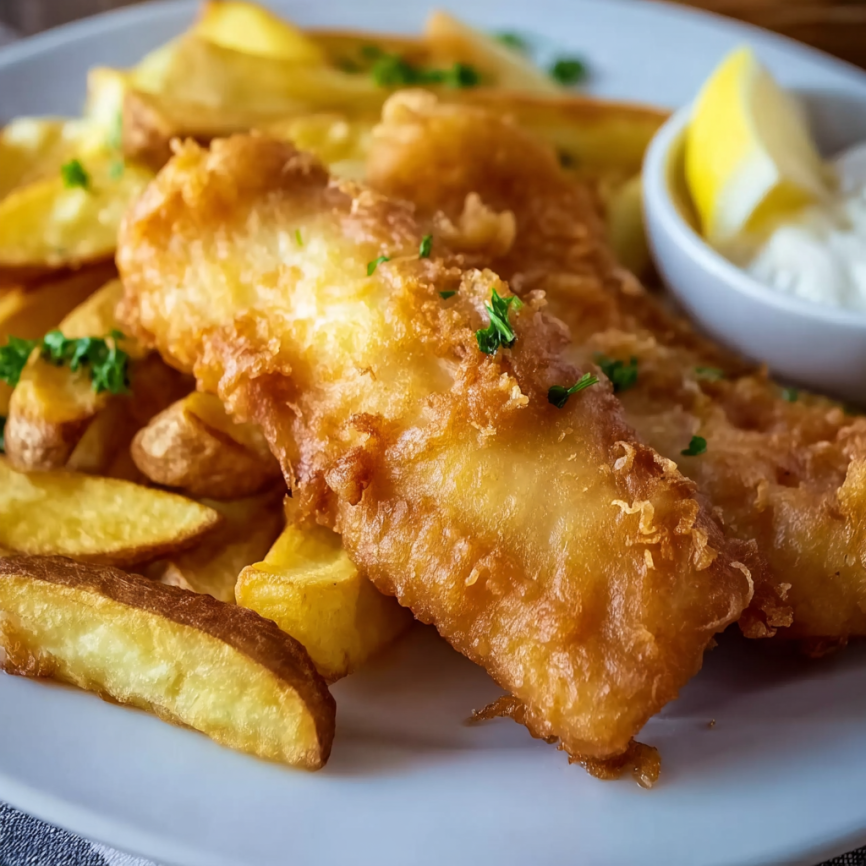There’s something profoundly satisfying about the sound of perfectly crispy batter crackling as you bite into authentic fish and chips. My first taste of proper British fish and chips happened on a drizzly afternoon in a seaside town, where the local chippy had been serving the same recipe for three generations. The golden, beer-light batter gave way to flaky white fish, while the chunky chips – never fries – provided the perfect starchy foundation for a generous splash of malt vinegar.
This iconic dish represents more than just comfort food; it’s a testament to British culinary heritage that has remained virtually unchanged for over a century. The secret lies in achieving that distinctive light, crispy batter that shatters at first bite, revealing tender fish within. Moreover, the twice-cooked chips develop that coveted crispy exterior and fluffy interior that makes them worthy companions to the star of the show.
Total Time: 50 minutes
Yield: 4 generous servings
Diet: Can be made gluten-free with simple substitutions
Why This Recipe Creates Chippy-Quality Fish and Chips
This traditional approach delivers restaurant-quality results that rival the best British chippies. First, the combination of flour and cornstarch creates an incredibly light, shatteringly crisp batter that doesn’t mask the delicate fish flavor. Additionally, the double-frying technique for the chips ensures they achieve that perfect contrast between crispy exterior and fluffy interior.
What makes this recipe particularly authentic is the use of sparkling water in the batter – the carbonation creates tiny air bubbles that result in extra-light, golden coating. Furthermore, the specific temperature control and timing ensure both components finish cooking simultaneously, so everything arrives at the table piping hot.
The beauty of this dish lies in its simplicity and technique rather than exotic ingredients, proving that sometimes the most beloved foods are perfected through generations of small refinements rather than complex innovations.
Traditional Ingredients for Authentic Results
For the Perfect Fish:
- 500g fresh white fish fillets – Choose thick cod, haddock, or pollock for best texture and flavor
- 150g all-purpose flour – Forms the base of our crispy batter coating
- 50g cornstarch – The secret ingredient for extra-light, shatteringly crisp texture
- 1 teaspoon baking powder – Provides additional lift and lightness to the batter
- 250ml ice-cold sparkling water – Creates the airy texture that makes proper chip shop batter
- 1 teaspoon sea salt – Essential for seasoning the batter properly
For the Chunky Chips:
- 4 large Maris Piper or Russet potatoes – High-starch varieties that create fluffy interiors
- Vegetable oil for deep frying – Use neutral oil with high smoke point like sunflower or canola
- Sea salt for finishing – Coarse sea salt provides the authentic chip shop experience
Essential Accompaniments:
- Malt vinegar – The classic acidic contrast that cuts through the rich, fried elements
- Tartare sauce – Creamy, tangy complement that enhances the fish’s delicate flavor
Step-by-Step Technique for Chippy Perfection
Preparing the Chips First
Begin by peeling the potatoes and cutting them into thick, chip-shop style pieces – about 1/2 inch thick and 3-4 inches long. Avoid cutting them too thin, as proper British chips should be chunky with substantial fluffy centers.
Rinse the cut potatoes in cold water to remove excess starch, then blanch them in boiling salted water for exactly 5 minutes. This par-cooking process ensures they’ll have fluffy interiors when finished. Drain thoroughly and pat completely dry with clean kitchen towels – any moisture will cause dangerous oil splattering.
Setting Up for Deep Frying
Heat your oil to precisely 340°F (170°C) for the first fry. Working in batches to avoid overcrowding, fry the blanched chips for 5-6 minutes until they’re pale golden but not fully colored. Remove and drain on paper towels while you prepare the fish.
Increase the oil temperature to 375°F (190°C) for the final cooking stage – this higher temperature will create the signature crispy exterior on both fish and chips.
Creating the Perfect Batter
In a large mixing bowl, whisk together the flour, cornstarch, baking powder, and salt until completely combined. Make a well in the center and gradually pour in the ice-cold sparkling water while whisking continuously. The batter should be smooth but not overmixed – a few small lumps are perfectly acceptable and actually contribute to texture.
The consistency should coat a spoon but still drip off easily. If it’s too thick, add a splash more sparkling water; if too thin, whisk in a tablespoon of flour.
Achieving Golden, Crispy Fish
Pat the fish fillets completely dry with paper towels and season lightly with salt. Working with one piece at a time, dip each fillet into the batter, allowing excess to drip off, then carefully lower into the hot oil.
Fry for 4-5 minutes per side, depending on thickness, until the batter is deep golden brown and sounds hollow when tapped. The fish should flake easily when tested with a fork and reach an internal temperature of 145°F (63°C).
The Final Chip Fry
While the fish drains on paper towels, return the partially cooked chips to the hot oil for their second fry. Cook for 2-3 minutes until they’re golden brown and crispy outside. This double-frying technique is what creates the perfect textural contrast.

Authentic British Presentation
Serve immediately on warm plates or, for true authenticity, wrapped in parchment paper. Arrange the fish alongside the chips, never on top, and provide malt vinegar and tartare sauce in separate small bowls. The traditional accompaniment is mushy peas, though a simple side salad works well for modern palates.
Finish with a generous sprinkle of sea salt and encourage diners to add malt vinegar liberally – it’s not just condiment but an essential flavor component that cuts through the richness and enhances the fish’s natural sweetness.
Regional Variations and Modern Twists
Different regions across Britain have their own fish and chips traditions. Northern England often prefers haddock over cod, while Scotland might include haggis alongside the fish. Some modern variations incorporate beer into the batter instead of sparkling water, creating an even richer flavor profile.
For those seeking lighter options, consider oven-baking the chips after the initial blanching, though this won’t achieve the same textural perfection. Additionally, sweet potato chips make an interesting contemporary variation, though purists might object to this departure from tradition.
Gluten-free versions work excellently using rice flour or dedicated gluten-free flour blends, maintaining the same light, crispy texture that makes this dish so beloved.
Strategic Preparation and Timing
The key to serving restaurant-quality fish and chips lies in careful timing coordination. Start the chips first since they require longer overall cooking time, then prepare the batter while they’re blanching. This ensures both components finish simultaneously and arrive at the table at peak crispiness.
If preparing for a crowd, keep cooked fish warm in a 200°F (90°C) oven for up to 10 minutes, though they’re best served immediately. The chips can also be held warm briefly, though they begin losing their crispiness after about 15 minutes.
For dinner parties, consider setting up a proper deep-frying station where you can cook to order – the theatrical element of fresh-fried fish and chips adds excitement to the dining experience.
Professional Frying Tips
Temperature control is absolutely critical for achieving chippy-quality results. Invest in a reliable thermometer and maintain consistent oil temperature throughout cooking. If the oil is too cool, the coating will absorb grease and become soggy; too hot, and the exterior burns before the fish cooks through.
Never overcrowd the fryer – this drops the oil temperature dramatically and results in uneven cooking. Work in small batches, allowing the oil to return to proper temperature between additions.
Use enough oil to allow the fish to float freely without touching the bottom of the pot. This prevents sticking and ensures even browning on all surfaces.
Essential Storage and Safety Notes
Fresh fish should be used within 24 hours of purchase for optimal flavor and texture. Store it in the coldest part of your refrigerator and pat dry thoroughly before battering to ensure proper adhesion.
Leftover batter should be discarded after use, as it contains raw fish proteins and cannot be safely stored. However, unused dry batter mix can be stored in an airtight container for several weeks.
Always ensure oil is completely cooled before disposal, and never pour used frying oil down drains as it can cause serious plumbing issues and environmental damage.

Frequently Asked Questions
What’s the best fish for traditional fish and chips? Cod is the gold standard, offering firm, flaky texture and mild flavor that pairs perfectly with the crispy batter. Haddock is equally traditional and slightly sweeter, while pollock provides a more budget-friendly option without sacrificing quality. Avoid oily fish like salmon, which don’t suit this preparation method.
Why is my batter not crispy enough? Several factors contribute to soggy batter: oil temperature too low, batter too thick, or fish not dried properly before coating. Ensure your oil reaches 375°F, use ice-cold sparkling water in the batter, and always pat fish completely dry before dipping.
Can I make the batter ahead of time? Fresh batter produces the best results, but you can prepare it up to 30 minutes before use. Keep it refrigerated and give it a gentle stir before using. The sparkling water loses its carbonation over time, which reduces the batter’s lightness.
How do I know when the fish is properly cooked? Properly cooked fish flakes easily when tested with a fork and reaches an internal temperature of 145°F (63°C). The batter should be deep golden brown and sound hollow when tapped gently. Cooking time varies with thickness, typically 4-5 minutes per side for standard fillets.
What oil is best for deep frying? Use neutral oils with high smoke points like vegetable, canola, or sunflower oil. Avoid olive oil, which has too low a smoke point, and never mix different types of oil as they have different heating properties.
Why do my chips go soggy? Soggy chips usually result from inadequate draining after blanching, overcrowding during frying, or insufficient oil temperature. Always pat chips completely dry after blanching, fry in small batches, and maintain proper oil temperature throughout cooking.
Nutritional Information (per serving):
- Calories: 600
- Protein: 25g
- Carbohydrates: 70g
- Fat: 30g (5g saturated, 20g unsaturated, 0g trans)
- Fiber: 5g
- Sugar: 2g
- Sodium: 800mg
- Cholesterol: 60mg
Recipe Details:
- Prep Time: 30 minutes
- Cook Time: 20 minutes
- Category: Traditional British Main Course
- Method: Deep frying
- Cuisine: British

